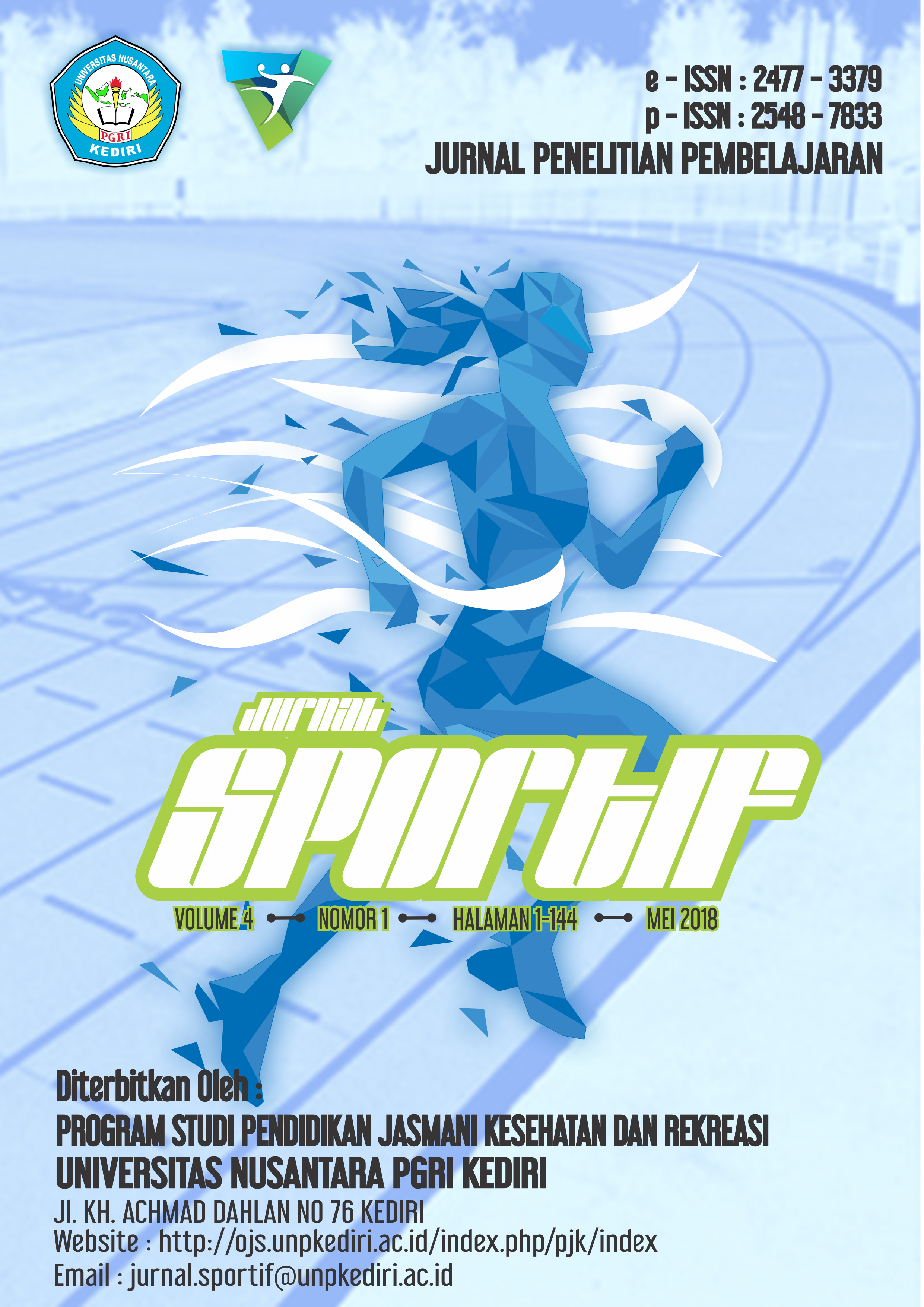Abstract
Latihan plyometric merupakan bentuk latihan yang cukup beraneka ragam. Dalam penelitian ini peneliti hanya menggunkan tiga bentuk latihan yaitu jump to box, depth jump dan single-leg depth jump. Penelitian ini bertujuan untuk menganalisis pengaruh latihan jump to box, depth jump dan single-leg depth jump terhadap peningkatan kekuatan otot tungkai dan power otot tungkai. Subyek penelitian ini adalah siswa SMA Negeri 1 Ngunut yang mengikuti ektrakurikuler degan jumlah subjek 40 siswa berjenis kelamin laki-laki. Jenis penelitian yang digunakan adalah kuantitatif dengan metode eksperimen semu. Rencana penelitian ini menggunakan matching-only design dan dianalisis menggunakan Anova. Proses pengambilan data kekuatan otot tungkai menggunakan leg dynamo meter dan power otot tungkai menggunakan jump MD pada saat pre test dan post test. Selanjutnya data dianalisis menggunakan SPSS versi 21. Hasil penelitian ini menunjukkan adanya pengaruh latihan jump to box, depth jump dan single-leg depth jump terhadap peningkatan kekuatan otot tungkai dan power otot tungkai. Sehingga dapat disimpulkan bahwa latihan jump to box, depth jump dan single-leg depth jump sangat efisien untuk meningkatkan kekuatan otot tungkai dan power tungkai.
References
Ambarwati, D. R., Widiastuti, W., & Pradityana, K. (2017). Pengaruh Daya Ledak Otot Lengan, Kelentukan Panggul, dan Koordinasi terhadap Keterampilan Tolak Peluru Gaya O’Brien. Jurnal Keolahragaan, 5(2), 207–215. Retrieved from https://journal.uny.ac.id/index.php/jolahraga/article/view/14918/9874.
Arafat, R. T., Mintarto, E., & Kusnanik, N. W. (2018). The Exercise Effect Of Front Cone Hops And Zig-Zag Cone Hops Due To Agility And Speed. International Journal of Scientific and Research Publications, 8(2), 250-255.
Baro, M., Sonowal,. (2014). Effect of Selected Plyometric Exercise on Explosive Strength, Speed, and Agility. International Journal of Science and Research, (3)8, 877-878.
Bompa, T.O. & Buzzichelli, C. (2015). Periodization training for sports (Third Edition). United States of America: Human Kinetic.
Bompa, T.O. & Haff, G.G. (2009). Periodezation Theory and Methodology of Training. United States of America. Human Kinetics.
Chu, D, A, Myer, G, D. (2013). Plyometrics. United States of America: Human Kinetics.
Hidayat, T., Saichudin, S., & Kinanti, R. G. (2017). Pengaruh Latihan Plyometric Depth Jump dan Jump To Box Terhadap Power Otot Tungkai pada Pemain Ekstrakurikuler Bolavoli SMK Teknologi Nasional Malang. Jurnal Sport Science, 7(1), 66-73.
Maksum, A. (2012). Metodologi Penelitian Dalam Olahraga. Surabaya: Unipress.
Mirzaei, B., Norasteh, A. A., Villareal, E. S. de, & Asadi, A. (2014). Effects Of Six Weeks Of Depth Jump Vs. Countermovement Jump Training On Sand On Muscle Soreness And Performance. Kinesiology, 46(1), 97–108.
Muhamad, Yanuar R. (2015). Pengaruh Latihan Front Box Jump Dan Kneeling Squat Jump Terhadap Kekuatan Otot Punggung, Kekuatan Otot Tungkai, dan Power Otot Tungkai (Tesis Magister pendidikan tidak dipublikasikan) Universitas Negeri Surabaya.
Perikles, E. Y., Mintarto, E., & Hasan, N. (2016). Pengaruh Latihan Jump To Box , Front Box Jump , dan Depth Jump Terhadap Peningkatan Explosive Power Otot Tungkai dan Kecepatan. Media Ilmu Keolahragaan Indonesia, 6(1), 8–14. Retrieved from https://journal.unnes.ac.id/nju/index.php/miki/article/view/7128.
Sukadiyanto & Muluk, D. 2011. Pengantar Teori dan Metodologi Melatih Fisik. Bandung: Lubuk Agung.
Sukadiyanto, (2011). Pengantar Teori dan Metodologi Melatih Fisik. Bandung : Lubuk Agung.
Authors who publish with this journal agree to the following terms:
- Copyright on any article is retained by the author(s).
- The author grants the journal, the right of first publication with the work simultaneously licensed under a Creative Commons Attribution License that allows others to share the work with an acknowledgment of the work’s authorship and initial publication in this journal.
- Authors are able to enter into separate, additional contractual arrangements for the non-exclusive distribution of the journal’s published version of the work (e.g., post it to an institutional repository or publish it in a book), with an acknowledgment of its initial publication in this journal.
- Authors are permitted and encouraged to post their work online (e.g., in institutional repositories or on their website) prior to and during the submission process, as it can lead to productive exchanges, as well as earlier and greater citation of published work.
- The article and any associated published material is distributed under the Creative Commons Attribution-ShareAlike 4.0 International License





